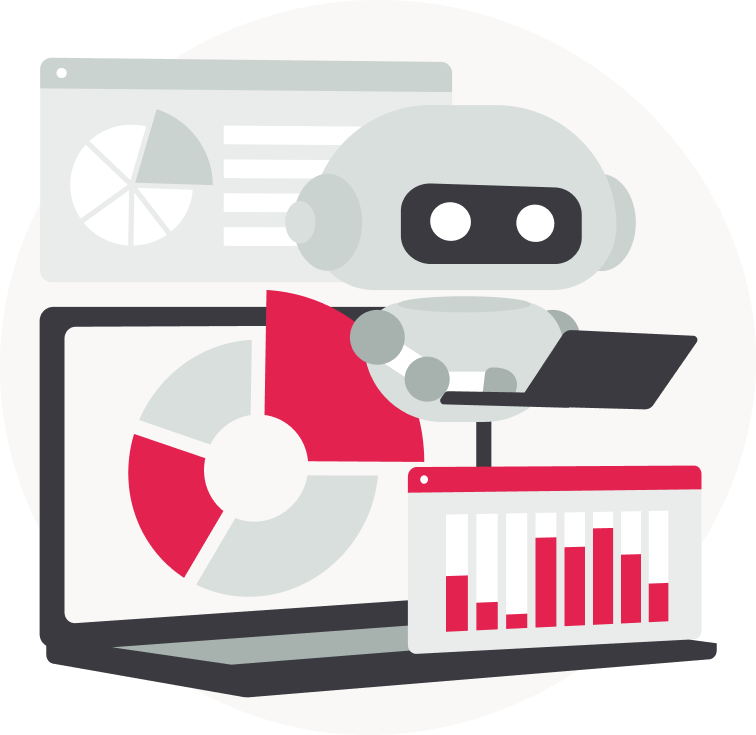Great software, zero headaches
AI Readiness
At Altamira, we remove the complexities that often make AI feel out of reach. As your zero headaches software partner, we provide a roadmap to success, taking out risks at every step, so nothing keeps you up at night.
15+
Years expertise
140+
Happy
clients
95%
Client
retention

Solve today's challenges
-
"Our AI adoption doesn’t seem to align with business goals."
We identify high-value use cases and measurable outcomes to ensure your AI investments drive real business impact with zero headaches in the process.
-
"Our data isn’t ready for AI."
We assess and improve your data infrastructure to ensure clean, reliable data, preventing costly setbacks.
-
"Is AI even the right solution for us?"
We assess feasibility, selecting the best models and architectures to help you get to value sooner.
-
"Our AI models aren’t integrating well with existing systems."
Our approach guarantees smooth scaling and integration, preventing siloed solutions and aligning with your tech stack.
-
"AI adoption seems overwhelming with all the compliance and security issues."
We address operational and regulatory concerns upfront to make AI technology work for you faster.
-
"Our AI projects are going over budget or missing the mark."
We spot hidden costs and set realistic expectations to avoid surprises, keeping your AI initiatives on track.
Our clients












Want to check if your business is ready for AI?
For the AI readiness assessment, we may initiate a Discovery phase to support complex research or create a PoC for deep technical evaluation.
Run a Discovery to make smart strategic decisions
We immerse into your business during the Discovery stage to select the best suitable solution for the particular case.
Audit your existing AI solution
If you already have an AI solution in place, we will conduct a thorough audit to uncover areas for improvement, ensuring maximum value.
Assess the landscape
We help you evaluate different AI technologies, tools, and platforms to determine which best meets your needs.
Identify integration challenges
Understand how AI technologies fit into your existing systems and workflows and plan the integration mindfully.
Understand data availability and quality
Assess if you already have sufficient, relevant, and high-quality data for model training and validation.
Set the right objectives
Identify the exact problem your AI solution should resolve and establish its expected business impact.
Estimate budget and timeline
Get a realistic roadmap for development, testing, and deployment to secure smooth and stress-free progress throughout your AI project.
Result
Implementation project plan
Time required
4 weeks
Cost
$25,000-$30,000
Build AI PoC to transform your brave ideas into reality
Test your idea in the real world without heavy time or resource investment. It’s a cost-effective way to check if you’re going the right direction.
We start by turning your ideas into small-scale prototypes to evaluate its viability, ensuring a strong foundation for the next development stage.
Assess technical readiness
Check if the proposed solution is feasible within your current IT setup and business model before investing significant resources.
Identify possible risks
Spot and assess any potential technical, operational, and business risks early in the process.
Demonstrate the value
Showcase the potential value and return on investment to your stakeholders and decision-makers.
Result
Working prototype that showcases key capabilities
Time required
1 week
Cost
$10,000
PoC delivered, what’s next?
Results evaluation
We carefully assess the results and findings of the PoC to determine whether it meets the intended goals and provides the expected value.
Business case validation
We will build a complex business case that justifies further investment. At this stage, you will clearly understand the potential benefits of AI adoption, ROI, and how this technology can solve your specific business challenges.
MVP development
If the PoC is promising, we proceed to develop a Minimum Viable Product. The MVP is a more comprehensive version of the AI solution that can be tested with a larger audience.
Continuous development roadmap
When working on a product or project development roadmap, we take into account scalability, data strategy, user adoption, change management, compliance, and security. As a result, you can make informed decisions regarding your AI investment strategies.
Benefits of an AI feasibility study
01 Avoid costly missteps
02 Optimise data strategy
03 Select the right AI approach
04 Streamline implementation
05 Ensure scalability and integration
06 Quantify business impact
Identify technical and business risks early to prevent wasted investment in unviable AI projects.
Ensure your data is structured, accessible, and sufficient for AI-driven insights.
Compare architectures, models, and frameworks to find the best fit for your needs.
Define a clear roadmap to move from concept to deployment with minimal friction.
Design AI solutions that work smoothly with your existing systems and scale as needed.
Get a realistic assessment of costs, expected outcomes, and long-term value before committing.
Why Altamira?
Get to value sooner
Our streamlined development process ensures you get the most value from your investment.
Be always in control
Rest easy knowing you are staying up to date with the latest tech advances.
Build a product your customers love
Our delivery process removes risks at every step, so nothing keeps you up at night.
Discover why customers choose Altamira






The team was receptive to feedback, adapting resources to ensure effective collaboration.

CTO, SOLJETS
Ryan Crawford
Powerful web platform for aircraft brokerage.
Services we provided
- Discovery
- Web application development
I am absolutely satisfied with how my app looks and functions. It is exactly what I wanted to get when I decided to go with this team.

CEO & Co-founder, Aquiline Drones
Barry Alexander
A mobile large-scale project for the development of innovative drones for various needs, both civilian and government agencies, and the creation of digital services for them.
Services we provided
- Discovery
- Mobile application development

CTO, Ticker Tocker
Jonathan Kopnic
Trading platform development with education, broadcasting, and social networking modules, just to name a few. This intuitive platform helps to earn by trading and selling trading-related products.
Services we provided
- Discovery
- Vendor audit
- Web and mobile application development
Their holistic approach was evident in how professionally they integrated our ideas with their expertise, resulting in a product that totally meets our goals.

CEO, Elula
Deveren Fogle
Revolutionary empowerment tool for neuropsychological assessments and child’s academic success.
Services we provided
- Web and mobile application development
- Artificial Intelligence

CEO, CTRL Golf
Ian Cash
Golf training app that helps players improve their unique golf style, including a deep configuration of the swing goal, great visual support, advanced algorithms, and effective feedback.
Services we provided
- Discovery
- Mobile application development
- Software development

Head of Services, Universal Edition
Andreas Bintinger
Electronic document delivery ecosystem development for music publishing.
Services we provided
- Discovery
- Web application development
- Software development
People also asked
AI readiness is your organisation’s ability to successfully implement AI. Ensuring the right infrastructure, high-quality data, skilled talent, and streamlined processes from the onset helps remove the headaches of AI development further, securing effective AI adoption.
To prepare your data for AI, we need to make sure it is high-quality, well-structured, and properly labelled. We will standardise formats, eliminate duplicates and implement strong data governance practices to enhance AI model performance.
Getting AI-ready enables your organisations to use AI for automation, insights, and decision-making. It reduces inefficiencies, enhances competitiveness, and unlocks new opportunities for your business growth. Reach out to learn more about AI readiness process.
AI adoption is the process of integrating artificial intelligence technologies into your operations, workflows, and decision-making processes. AI integration covers implementing AI-powered tools and systems that automate tasks, analyse AI data readiness, provide data-driven insights, and improve various aspects of the business.
AI can assist in feasibility studies by analysing data, identifying risks, and predicting outcomes, but human expertise is still needed for strategic evaluation and decision-making.
We evaluate AI project feasibility by assessing your data availability, technical requirements, business value, costs, and potential risks. As a rule, we conduct a discovery or run a proof-of-concept project to validate AI’s effectiveness. Get in touch to learn more about our AI adoption framework.
The cost of AI readiness assessment depends on your project’s complexity, data requirements, and industry. The final cost may range from $10,000 to $25,000- $30,000
We start by defining the problem AI will solve, gathering relevant data, and consulting stakeholders. Then, analyse technical and financial feasibility before making an informed decision. Contact us to get a free expert consultation regarding AI adoption.
All our services
Services provided by Altamira
Artificial Intelligence
Outstaffing
Expertise
AI tech stack provided by Altamira
Machine Learning
Deep Learning
Big Data Processing
Related blog posts
Looking forward to your message!
- We will send you a confirmation email once your message is received
- Our experts will get back to you within 24h for a free consultation
- All information you provide will be kept confidential and protected under NDA
- We will provide an initial project estimate during your consultation




